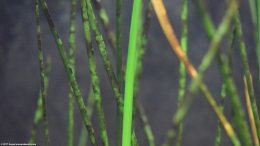A Dwarf Onion plant, also referred to as a Dwarf Water Onion plant, Zephyranthes candida, can be a pretty interesting plant to keep. A dwarf onion plant is often sold in pets stores displayed with the freshwater aquarium plants. But it is not a true aquatic plant. Dwarf onion is more of a terrarium plant or pond plant. That said, some hobbyists keep dwarf onion plants in their tanks because they like the look. A dwarf onion plant adds a nice grass-like green color to the background or mid-background. And Amano Shrimp and Red Cherry Shrimp like to climb up and down them, picking edible matter off their stems (for as long as the plant lasts).
Dwarf Onion Plant vs. Water Onion Plant
Because a dwarf onion plant, Zephyranthes candida, is often referred to as a “dwarf water onion” it may be confused with a similar looking bulb plant often sold as a “water onion”, Crinum thaianum. Both plants have white bulbs with roots on the bottom and green stems, but the stems are different. A dwarf onion plant stem looks more like a “scallion” stem, like a green tube or straw, while a water onion looks more like a “crab grass” leaf. And just because these plants may look like real onions, they are not. These plants are not edible.
Dwarf Onion Plant Image Gallery
Dwarf Onion Plant Care: Roots, Bulb & Stem
A dwarf onion plant has roots, a bulb and a stem. The roots grow down from the bottom of the bulb and are white and hard when healthy, looking something like young bean sprouts. When the roots die they turn brown in color and lose their firmness. As the roots decay, they look like strands of wet brown paper.
A dwarf onion plant bulb starts off small but grows to be about the size of a dime, and is white and firm. A dwarf onion plant bulb may be covered with a paper thin layer of brown membrane that sheds as it grows. As the bulb matures, it has a round shape for the most part being flatter on the bottom, round in the middle and tampering off to a point on the top.
A dwarf onion plant reproduces by growing smaller offspring bulbs on the side of the main bulb. As the smaller offspring bulbs mature, they break off from the main bulb and root and grow in their own right. And the main bulb continues to grow, unharmed.
The stems of a dwarf onion plant are green, firm and grow up from the bulb toward the water surface. Because the stems grow straight up, a dwarf onion plant adds a nice background to a tank. That said, they could be used in the foreground if one is going for a “forest look”. At times, the tips of the stems may turn yellow or orange-ish in color. When that happens, just snip off the discolored tips of the stem and the plants seem to be not hurt by that.
Dwarf Onion Plant Care
Although the dwarf onion plant is a terrarium plant, a cluster of dwarf onions can be very hardy. They can do well for a while in aquarium water in the the tropical fish range: water temperature around 78 degrees Fahrenheit, pH slightly on the alkaline side at 7.4, with moderate to high light.
Planting Dwarf Onion Bulbs Requires Patience
Planting dwarf onion bulbs can be tricky. Its tempting to plant the bulbs deeply in substrate to make sure the stay in place. But its important not to plant the bulbs too deeply. The bulbs should be visible to the eye, and should be planted with about 1/3 of the bottom of the bulb in the substrate, at most. This may be frustrating because the bulb roots may not be sufficiently grown to hold the plant firmly in place at first, and the plants may uproot and float around a bit. But patience pays off. Keep trying to get the roots to hold the bulbs in place until the roots grow strong enough to dig in on their own.
I’ve made the mistake of not planting some bulbs properly. The bulbs turned green like the stems. After noticing the green color, I replanted the the bulbs properly. I am waiting to see if the bulbs will lose their green color and turn white again.
Update: After about four weeks, the dwarf onion plant bulbs that turned green seem to have all turned white again. So it looks like replanting the green bulbs properly worked. But in the end, the plants did not do well fully submerged in water, and they ultimately died.






















